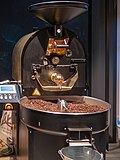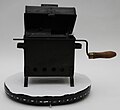Coffee roasting
Coffee roasting is a process that transforms the chemical and physical properties of green coffee beans into roasted coffee products. The roasting process is what produces the characteristic flavor of coffee by causing the green coffee beans to expand and to change in color, taste, smell, and density. This process is an integral part of coffee production all over the world.
History[edit]
The practice of roasting coffee beans has been around for centuries, with the first known methods involving simply heating the beans on a pan. Over time, the process has evolved and become more sophisticated, with modern roasting machines able to control temperature and roasting time with precision.
Process[edit]
The process of coffee roasting involves several stages, each of which contributes to the final flavor of the coffee. These stages include drying, first crack, caramelization, second crack, and cooling. Each stage requires careful control of temperature and time to ensure the best possible flavor.
Drying[edit]
The first stage of roasting is drying, where the green coffee beans are heated to remove moisture. This stage typically lasts for several minutes and prepares the beans for the next stages of roasting.
First Crack[edit]
The first crack stage is when the beans begin to pop and crackle as they expand. This stage is often considered the beginning of the actual roasting process, as it is during this stage that the beans begin to develop their flavor.
Caramelization[edit]
During the caramelization stage, the sugars in the beans begin to caramelize, contributing to the flavor and color of the coffee. This stage is also when the beans begin to develop their aroma.
Second Crack[edit]
The second crack stage is when the beans crack again, signaling the end of the roasting process. After this stage, the beans are quickly cooled to stop the roasting process and to preserve their flavor.
Cooling[edit]
The final stage of roasting is cooling, where the beans are quickly cooled to stop the roasting process and to preserve their flavor. This is typically done by blowing air over the beans or by immersing them in water.
Roasting Methods[edit]
There are several methods of roasting coffee, each with its own advantages and disadvantages. These methods include air roasting, drum roasting, and hot-air gun roasting.
Air Roasting[edit]
Air roasting is a method where hot air is used to roast the beans. This method is known for its consistency and control over the roasting process.
Drum Roasting[edit]
Drum roasting is a method where the beans are roasted in a rotating drum. This method is known for its ability to roast large batches of beans at once.
Hot-Air Gun Roasting[edit]
Hot-air gun roasting is a method where a hot-air gun is used to roast the beans. This method is known for its flexibility and control over the roasting process.
See Also[edit]
Ad. Transform your life with W8MD's Budget GLP-1 injections from $75


W8MD offers a medical weight loss program to lose weight in Philadelphia. Our physician-supervised medical weight loss provides:
- Weight loss injections in NYC (generic and brand names):
- Zepbound / Mounjaro, Wegovy / Ozempic, Saxenda
- Most insurances accepted or discounted self-pay rates. We will obtain insurance prior authorizations if needed.
- Generic GLP1 weight loss injections from $75 for the starting dose.
- Also offer prescription weight loss medications including Phentermine, Qsymia, Diethylpropion, Contrave etc.
NYC weight loss doctor appointmentsNYC weight loss doctor appointments
Start your NYC weight loss journey today at our NYC medical weight loss and Philadelphia medical weight loss clinics.
- Call 718-946-5500 to lose weight in NYC or for medical weight loss in Philadelphia 215-676-2334.
- Tags:NYC medical weight loss, Philadelphia lose weight Zepbound NYC, Budget GLP1 weight loss injections, Wegovy Philadelphia, Wegovy NYC, Philadelphia medical weight loss, Brookly weight loss and Wegovy NYC
|
WikiMD's Wellness Encyclopedia |
| Let Food Be Thy Medicine Medicine Thy Food - Hippocrates |
Medical Disclaimer: WikiMD is not a substitute for professional medical advice. The information on WikiMD is provided as an information resource only, may be incorrect, outdated or misleading, and is not to be used or relied on for any diagnostic or treatment purposes. Please consult your health care provider before making any healthcare decisions or for guidance about a specific medical condition. WikiMD expressly disclaims responsibility, and shall have no liability, for any damages, loss, injury, or liability whatsoever suffered as a result of your reliance on the information contained in this site. By visiting this site you agree to the foregoing terms and conditions, which may from time to time be changed or supplemented by WikiMD. If you do not agree to the foregoing terms and conditions, you should not enter or use this site. See full disclaimer.
Credits:Most images are courtesy of Wikimedia commons, and templates, categories Wikipedia, licensed under CC BY SA or similar.
Translate this page: - East Asian
中文,
日本,
한국어,
South Asian
हिन्दी,
தமிழ்,
తెలుగు,
Urdu,
ಕನ್ನಡ,
Southeast Asian
Indonesian,
Vietnamese,
Thai,
မြန်မာဘာသာ,
বাংলা
European
español,
Deutsch,
français,
Greek,
português do Brasil,
polski,
română,
русский,
Nederlands,
norsk,
svenska,
suomi,
Italian
Middle Eastern & African
عربى,
Turkish,
Persian,
Hebrew,
Afrikaans,
isiZulu,
Kiswahili,
Other
Bulgarian,
Hungarian,
Czech,
Swedish,
മലയാളം,
मराठी,
ਪੰਜਾਬੀ,
ગુજરાતી,
Portuguese,
Ukrainian







